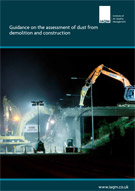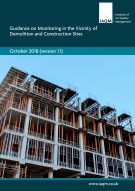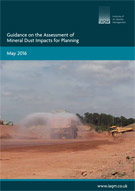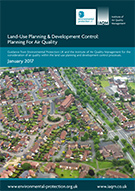Guidance
The IAQM is committed to enhancing the understanding and development of the science behind air quality by promoting knowledge and understanding of best working practices. Therefore from time-to-time we publish guidance and recommendations to aid members in their work.
Construction Guidance
Assessment of dust from demolition and construction 2024 V2.2
This is a revised version of the updated guidance due to a number of identified errors in version 2.1. Details of corrections from version 2.1 to 2.2 can be found in this document. Substantive changes from version 1 can be found at the end of the guidance document.
The document provides guidance for developers, their consultants and environmental health practitioners on how to undertake a construction impact assessment (including demolition and earthworks). The impacts of dust depend on the mitigation measures adopted. The emphasis in this document is therefore on classifying the risk of dust impacts from a site, which will then allow appropriate mitigation measures to be identified.
This is a rewrite of previous guidance published in 2014, adopting the lessons learnt from the application of the previous guidance. Please note that, in relation to small particulates, this guidance is focused on PM10. This is due to a current lack of empirical evidence regarding PM2.5 emissions from construction sites specifically. Updates to this guidance will be made where appropriate as more evidence on PM2.5 is gathered.
Construction Guidance
WITHDRAWN: Assessment of dust from demolition and construction 2023 V2.1
This version was withdrawn in light of a number of identified errors.
The document provides guidance for developers, their consultants and environmental health practitioners on how to undertake a construction impact assessment (including demolition and earthworks). The impacts of dust depend on the mitigation measures adopted. The emphasis in this document is therefore on classifying the risk of dust impacts from a site, which will then allow appropriate mitigation measures to be identified.
This is a rewrite of previous guidance published in 2014, adopting the lessons learnt from the application of the previous guidance. Please note that, in relation to small particulates, this guidance is focused on PM10. This is due to a current lack of empirical evidence regarding PM2.5 emissions from construction sites specifically. Updates to this guidance will be made where appropriate as more evidence on PM2.5 is gathered.
Indoor Air Quality Guidance
 Indoor Air Quality Guidance: Assessment, Monitoring, Modelling and Mitigation
Indoor Air Quality Guidance: Assessment, Monitoring, Modelling and Mitigation
This guidance has been produced to assist its members and others in the assessment of indoor air quality. It is guidance for appropriately qualified practitioners working on improving indoor air quality. It has been endorsed by the Chartered Institute of Building Services Engineers (CIBSE).
Air quality impacts on nature sites Guidance
A guide to the assessment of air quality impacts on designated nature conservation sites 2020
Air pollution damage to protected wildlife sites is often overlooked due to the current emphasis on its effect on human health. This publication signposts the appropriate thresholds used by local authorities, the Environment Agency and other regulators to conclude that there will not be a significant effect. When these thresholds are exceeded, a suitably qualified and experienced ecologist must determine whether there is likely to be a significant effect on the habitat. The guide stresses the importance of air quality and ecology specialists working closely together.
Demolition/Construction Site Monitoring Guidance
Air Quality Monitoring in the Vicinity of Demolition and Construction Sites 2018
Constructing buildings, roads and other infrastructure can have a substantial, temporary impact on local air quality. This document provides updated guidance on air quality monitoring in the vicinity of demolition and construction sites. It should be read and applied in conjunction with the Guidance on the assessment of dust from demolition and construction 2014 that was published by the IAQM in January 2014.
Odour Guidance
Guidance on the assessment of odour for planning 2018 v1.1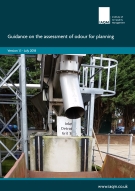
Some guidance on odour assessment is already available from the national Government, the Scottish Environmental Protection Agency (SEPA) and the Environment Agency (EA). However, none of this specifically provides guidance applicable for planning purposes. This IAQM document has been prepared to assist practitioners involved in odour assessment for planning.
Minerals Guidance
Guidance on the Assessment of Mineral Dust Impacts for Planning 2016 v1.1
This IAQM document has been prepared to assist practitioners undertake dust assessments for mineral sites. It aims to provide advice on robust and consistent good-practice approaches that can be used to assess the operational phase dust impacts. This guidance is designed for use in the planning process; it is not designed for other purposes such as Environmental Permitting.
Planning Guidance
Guidance on land-use planning and development control: Planning for air quality 2017 v1.2
Environmental Protection UK (EPUK) and the Institute of Air Quality Management (IAQM) have produced this guidance, which replaces the 2010 EPUK Guidance document, to ensure that air quality is adequately considered in the land-use planning and development control processes.
Construction Guidance
Assessment of dust from demolition and construction 2014
The document provides guidance for developers, their consultants and environmental health practitioners on how to undertake a construction impact assessment (including demolition and earthworks). The impacts of dust depend on the mitigation measures adopted. The emphasis in this document is therefore on classifying the risk of dust impacts from a site, which will then allow appropriate mitigation measures to be identified.
This guidance had a minor update in 2016, listed at the start of the guidance.
Significance Guidance (Replaced)
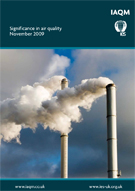 Significance in Air Quality, November 2009
Significance in Air Quality, November 2009
Following discussion amongst the membership, the Institute has prepared recommendations for assessing the significance of air quality impacts.
This guidance was replaced by the Planning Guidance published in 2015 and available above.
Dealing with Uncertainty in Vehicle NOx Emissions Within Air Quality Assessments: Withdrawn
Mitigation of Development Air Quality Impacts V1.1 (2018)
Competent Air Quality Expert for Environmental Impact Assessment (2018)
Assessment of Air Quality Impacts from Combustion Plant with Limited-hours of Operation (2017)
Mitigation Measures: Ambient Pollution Removal Techniques (2019)
Use of Screening Tools for Preliminary Determination of the Significance of Pollutant Sources (2020)
Use of 2020 and 2021 Monitoring Datasets V1.1 (2023)
